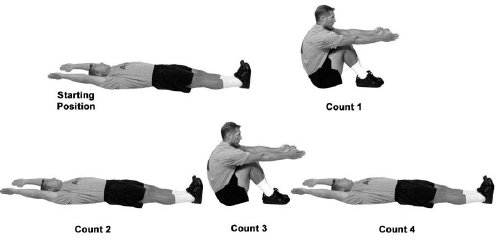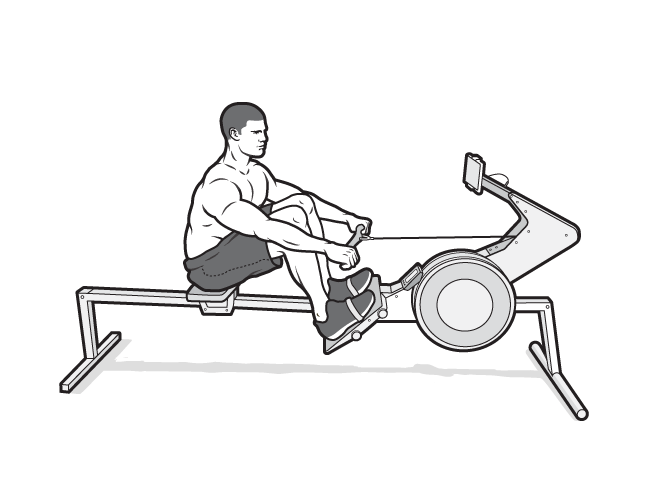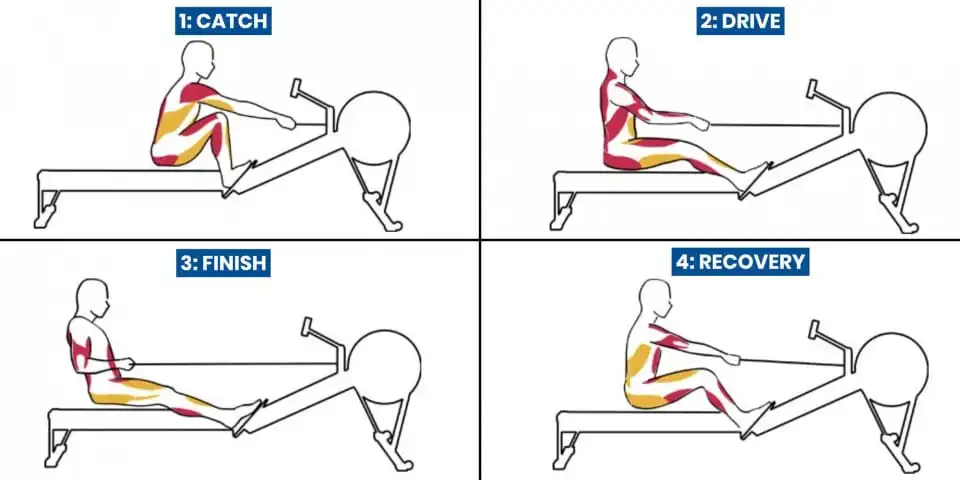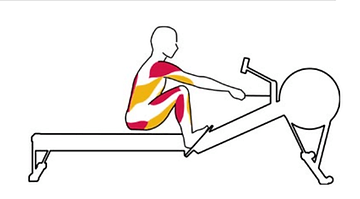The Rower is a core and full-body exercise that mimics the motion of rowing a boat; this exercise helps improve strength, endurance, and coordination while targeting multiple muscle groups.
The Rower exercise works on the following muscle groups:
- Abs
- Hip flexors
- Shoulders
- Arms
- Legs.
You can row with or without a machine.
Rowing on a machine, also known as an ergometer, is a highly effective full-body exercise that targets a wide range of muscles while also improving cardiovascular fitness.
I will start by covering rowing without machines and then move to rowing with a machine.
Army PRT Rowing Preparation Drill Exercise

The Rower is the fourth exercise in the Army Prep Drills. This exercise aims to improve abdominal strength and total body coordination.
Purpose:
- It prepares the soldier to transition from a supine to a seated position and readies them for conditioning and climbing drill exercises.
Starting Position:
- Begin in the supine position, arms overhead, feet together, and pointing upward.
- The chin is tucked, and the head is 1-2 inches above the ground to engage the muscles in the front of the neck.
- Arms are shoulder-width, palms facing inward with fingers and thumbs extended and joined.
Cadence:
- SLOW
Count:
- On Count One: Sit up while swinging your arms forward and bending at the hip and knees. At the end of the motion, the arms will be parallel to the ground with palms facing inward.
- On Count Two: Reverse the movement performed in count one to return to the starting position.
- On Count Three: Repeat count one.
- On Count Four: Return to the starting position.
Repetitions: Perform five to ten repetitions.
Here is the movement in real-time.
Precautions: This exercise is always performed at a slow cadence. Do not arch the back to assume counts 1 and 3.
Check Points:
- Ensure correct form and controlled movements for maximum effectiveness and to avoid injury.
- Keep the head slightly elevated throughout the exercise to engage the neck muscles.
- Ensure feet are flat on the ground and knees are positioned between the arms at the end of count one.
The Army PRT Preparational Drill has nine other exercises, as follows:
- Ben and Reach Army
- Rear Lunges
- High Jumper Exercise
- Squat Bending
- Windmill Exercises
- Forward Lunges
- Prone Rows
- Bent Leg Body Twists
- Push Ups
Rowing Machine Exercise & Workout Guide

In this section, we’ll introduce you to the fundamentals of rowing machine workouts and how to get started confidently.
Rowing Positions
These are the four basic positions for rowing machines:
| Rowing Positions | Description | Primary Muscles Engaged |
|---|---|---|
| Catch Position | This is where you reverse the positions, starting with the legs, then the body, and finishing with the arms. | Quadriceps, Core, Forearms |
| Drive | This is where you reverse the positions starting with the legs, then the body, and finishing with the arms. | Quadriceps, Glutes, Upper back (latissimus dorsi, trapezius, rhomboid), Deltoids, Biceps, Triceps |
| Finish Position | In this position, your legs are straight, your torso is leaning back slightly, and your arms are drawn in towards your body. | Core, Upper back, Biceps, Triceps |
| Recovery (Arms Away/Bodies Over) | In this position, your arms and torso move, but your legs stay straight. | Deltoids, Core, Quadriceps, Hamstrings |
How to Row on a Rowing Machine
Follow the following step-by-step instructions to row on a rowing machine.
- Adjust your footrest:
Place your feet on the footrests and adjust the strap so it goes across the ball of your foot.
- Get the right grip.
Sit on the seat, bend forward at the hips, and grab the handle. Your grip should be loose with palms parallel and thumbs wrapped underneath the handle.
- Get into the catch position.
Slide up the rail until your shins are vertical and you are reaching forward to grab the handle, keeping your back straight.
- Start the drive
Initiate the drive by pushing with your legs. Your arms should remain straight, and your back should remain still at this stage.
- Engage your back
As your legs straighten, lean your upper body back slightly and keep pulling the handle towards you.
- Pull the handle
Once your legs are fully extended, and your back is slightly reclined, pull the handle towards your lower chest. Elbows should be pointed out and back, not flared wide, and your wrists should remain flat.
- Move into the recovery position.
Extend your arms, lean from the hips, and start sliding up the rail.
- Repeat the cycle
Once your hands pass your knees, bend your knees and slide up the rail to the catch position to start another cycle.
Benefits of Rowing Machines
Before diving into the techniques, let’s explore the many advantages of incorporating rowing machines into your workout routine.
Why Rowing?
Fundamental to the Human Body:
- Rowing is one of the most fundamental movements to the human body. It’s been done for thousands of years but is often neglected in modern society.
Total Body Movement:
- It connects your hands to your feet and utilizes 84% of the muscles in the body.
- All the major muscle groups are worked, providing the potential to develop power, strength, and endurance all within the same movement.
Diverse Targets:
- Whether you’re seeking to generate power and strength in short periods or build cardiovascular aerobic capacity over longer periods, rowing can cater to these goals. It builds fitness like no other sport.
Low Impact:
- Unlike running, which can put a lot of stress on the joints, rowing is low impact. This makes it accessible to almost anyone, regardless of age.
Unites Communities:
- Rowing is a sport that unites communities and people together. It’s great for your body and fitness, and it also has a skill component that adds an element of enjoyment to the rhythm of the movement.
- The most valuable aspect of rowing is that you can share it with others and be part of a community, which can elevate your fitness to another level.
Before diving into the techniques, let’s explore the many advantages of incorporating rowing machines into your workout routine:
Rowing Machine Technique & Tips (Perfect Form)

Rowing is a functional exercise that is easy to learn. Proper technique can help you get the most out of your workout.
At the Catch:
- At the catch, the body is in a powerful but relaxed position.
- Sit up tall with your shoulders in front of your hips.
- Shins are vertical.
- The head, neck, and shoulders are relaxed.
- The arms are long, and the grip is loose.
The Drive:
- The drive starts with a push of the legs, not a pull of the arms.
- To initiate the movement with your legs, drive the heels into the foot stretcher and push the machine away.
- Swing the body by opening from the hips.
- The seat and the handle should move simultaneously until the legs are fully extended.
- You pull with your arms only after your hands clear your knees.
The Finish:
- At the finish of each stroke, the core is engaged.
- The handle is pulled in below your rib cage.
- The wrists are flat.
- The arms move first, then the body swings forward, then the legs.
- The body stays still once the hips hinge.
The Recovery:
- When you return to the catch, you must change direction quickly to accelerate the flywheel again.
General Tips
- Blending together all the movements creates a smooth, powerful, continuous stroke.
- The sequence continues with legs, back, arms, then arms, back, and legs.
- Remember to push hard with the legs on the drive and relax on each recovery.
What are the muscles worked by the Rowing Machine?

- Quadriceps
- Hamstrings
- Glutes
- Core (including abs and lower back)
- Upper back
- Triceps
- Biceps
- Deltoids
- Forearms
Tailoring Your Indoor Rowing Experience
Now that you’ve got the basics down let’s explore how to customize your rowing workouts for different goals and fitness levels.
Rower Exercise for Beginners: Starting Strong
If you’re new to rowing, follow these tips to ease into the workout and build a solid foundation:
- Begin with shorter sessions (10-15 minutes) and gradually increase the duration
- Focus on form and technique over speed
- Experiment with different resistance levels to find the proper challenge
Rower Exercise Variations: Keep It Fresh
To prevent boredom and keep your workouts engaging, try these rowing variations:
- Interval training: Alternate periods of high-intensity rowing with recovery breaks
- Distance-based workouts: Set a target distance and challenge yourself to complete it in less time
- Race simulations: Compete against a virtual opponent or race the clock
Rowing Machine Tips, Tricks, and Comparisons
In this section, we’ll share some helpful advice for making the most of your rowing workouts and compare rowing machines to other popular cardio options.
Rowing Machine Tips and Tricks: Maximize Your Workout
To get the most out of your indoor rowing sessions, keep these tips in mind:
- Warm up before each workout to prepare your muscles and prevent injury
- Maintain a steady and consistent pace throughout your session
- Track your progress and set goals to stay motivated
Rower vs. Other Cardio Machines: Which Is Best for You?
While rowing machines offer unique benefits, it’s essential to consider how they compare to other cardio options:
- Treadmills: Higher impact but better suited for running-specific training
- Stationary bikes: Lower body-focused and less demanding on the upper body
- Ellipticals: Low impact but less dynamic than rowing
Ultimately, the best choice depends on your personal preferences and fitness goals.
Additional Considerations for Rowing Success
This final section cover workout plans, progressions, equipment recommendations, and safety precautions.
Rower Workout Plans: Structuring Your Sessions
To maximize your rowing results, consider following a structured workout plan:
- Start with a warm-up (5-10 minutes of light rowing)
- Incorporate intervals, distance challenges, or race simulations
- Finish with a cool-down (5 minutes of easy rowing)
Rower Exercise Progressions: Level Up Your Workout
As you become more experienced, gradually increase the intensity and duration of your workouts to continue challenging yourself.
Best Rowing Machines: Find Your Perfect Fit
Investing in a high-quality rowing machine is crucial for a comfortable and effective workout. Research and compare models to find the best option within your budget.
Rower Exercise Safety Precautions: Row Responsibly
Finally, always prioritize safety during your rowing workouts:
- Use proper form and technique to prevent injury
- Listen to your body and avoid overexertion
- Consult with a fitness professional if you have concerns or questions
Conclusion
Indoor rowing offers a fantastic full-body workout that can be tailored to any fitness level. You’ll soon be reaping the numerous benefits of rower exercises by mastering proper technique, incorporating variations, and following our tips and tricks. So, strap in, grab the handle, and row your way to better health and fitness!
- Empowering Transactions: Navigating Firearms Sales with Proper Documentation - April 8, 2024
- Army PRT – Preparation and Recovery 2024 - March 18, 2024
- Active and Reserve Components 2024 - March 6, 2024
